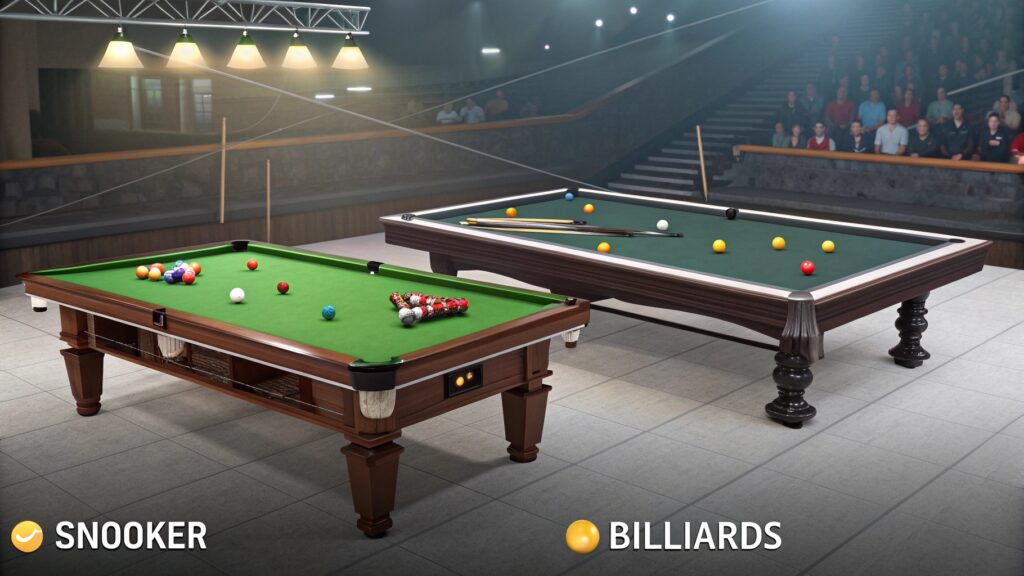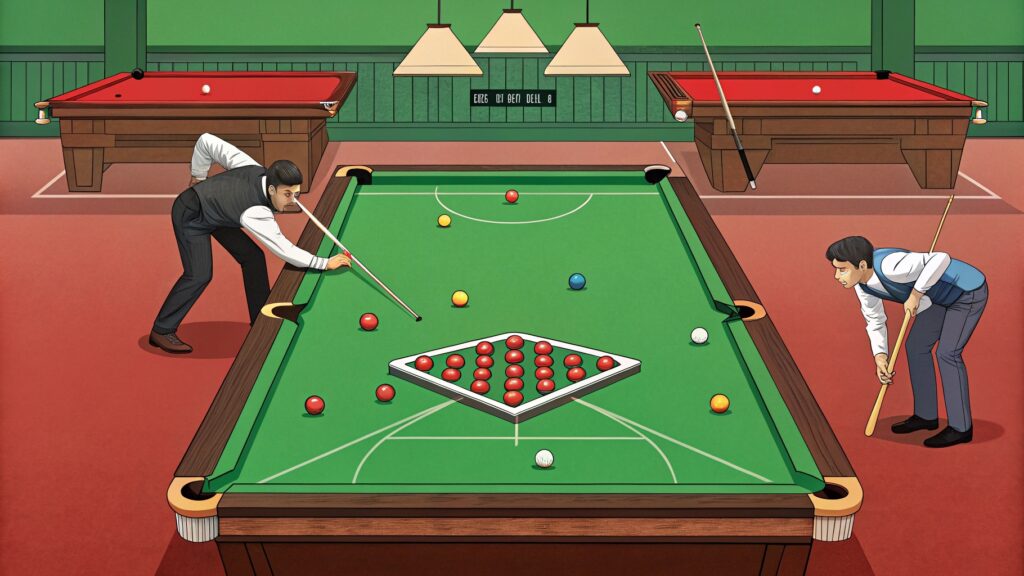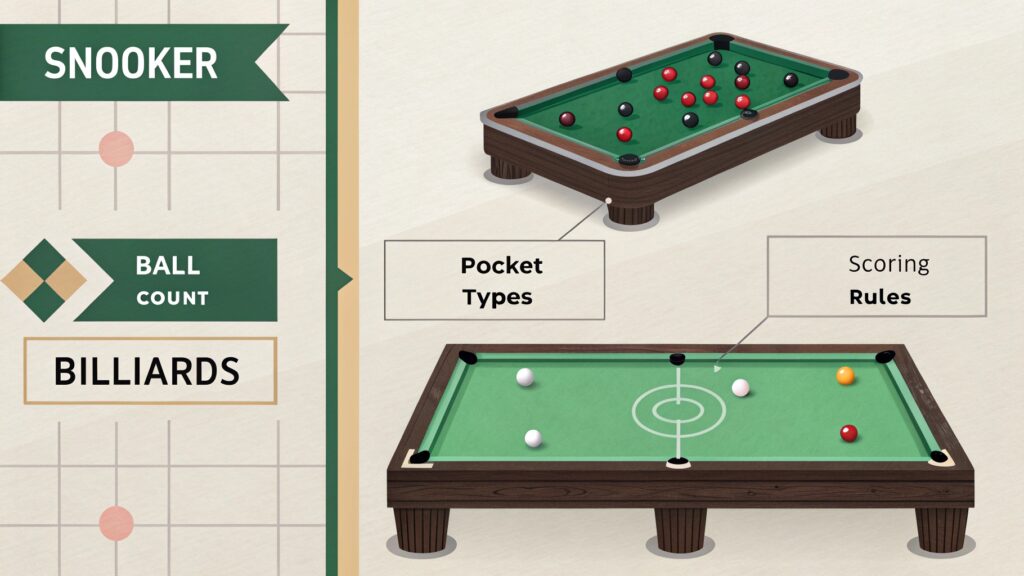Snooker and Billiards Difference: If you’ve ever walked into a sports bar, snooker hall, or seen a professional cue sport event on TV, chances are you’ve heard the terms snooker and billiards thrown around. While both involve green tables, cues, and precise shots, they’re actually two very different games — with their own unique rules, history, and charm.
So, what sets them apart? Why do some fans passionately follow Snooker and Billiards Difference while others admire the classic art of billiards?
In this post, we’ll take a deep dive into both cue sports, comparing everything from table sizes and ball types to rules and gameplay styles. Whether you’re a curious beginner, a fan of either game, or just love learning about fascinating sports, this guide will give you everything you need to know.

🟢 I. Introduction – Snooker and Billiards Difference
It’s a common misconception — people often use the words snooker and billiards interchangeably. And let’s be honest, from the outside, they do look quite similar. After all, both games are played on large green tables, involve cue sticks, and require immense skill and precision.
But in truth, Snooker and Billiards Difference are two distinct games with entirely different rules, equipment, and even fan bases. If you’ve ever found yourself confused between the two, you’re not alone.
This blog is here to clear up that confusion, break down the core differences, and help you understand why each game deserves its place in the world of cue sports and Snooker and Billiards Difference.

🟢 II. What Is Snooker?
📜 Origins and History
Snooker’s roots can be traced back to the British Army stationed in India during the late 19th century. It evolved from other cue sports like pyramid pool and black pool, with the now-familiar structure being developed by Colonel Sir Neville Chamberlain, Snooker and Billiards Difference.
The word snooker was a slang term used by military cadets for someone inexperienced — quite fitting for a new form of billiards at the time, Snooker and Billiards Difference.
🌍 Where It’s Popular
Today, Snooker and Billiards Difference is most popular in the United Kingdom, China, and parts of Southeast Asia. In fact, the sport has become so huge in China that major tournaments there draw millions of viewers. Other countries with dedicated fan bases include Australia, India, and some European nations.
🧠 Rules and Objective
Snooker is played on a 12 ft × 6 ft table with six pockets and 22 balls:
- 15 red balls (1 point each)
- 6 colored balls (yellow, green, brown, blue, pink, black – worth 2 to 7 points)
- 1 white cue ball
The goal? Score more points than your opponent by potting balls in a specific sequence: red followed by a color, then another red, and so on. Once all reds are cleared, players must pot the colors in ascending order of value.
The match is divided into frames, and players compete over several frames to determine the winner. Strategy, shot precision, and mental endurance are key.
👑 Professional Scene
Governed by the World Snooker Tour (WST), the sport boasts prestigious tournaments like:
- The World Championship (held annually at the Crucible Theatre)
- The UK Championship
- The Masters
Players like Ronnie O’Sullivan, Stephen Hendry, Mark Selby, and Judd Trump have become global icons in the snooker world and Snooker and Billiards Difference.

🟢 III. What Is Billiards?
📜 Historical Background
Billiards is actually the parent of most modern cue sports, including snooker and pool. Its history goes back to 15th-century Europe, where it began as an outdoor lawn game similar to croquet. Eventually, it was brought indoors and adapted to a felt-covered table.
When we talk about billiards today, we usually mean English Billiards, which became standardized in the 19th century and is still played professionally today.
🌍 Where It’s Popular
While billiards doesn’t enjoy the same global television coverage as snooker, it remains popular in countries like the UK, India (thanks to legends like Geet Sethi and Pankaj Advani), and parts of Southeast Asia and Snooker and Billiards Difference.
🧠 Rules and Objective
English Billiards is played on a snooker-sized table with just three balls:
- A white cue ball for Player 1
- A yellow cue ball for Player 2
- A red object ball
The game is all about scoring points, and there are three ways to do that:
- Potting – Hitting your cue ball so that it sinks the red or opponent’s cue ball.
- Cannon – Hitting both the red and opponent’s cue ball in a single shot.
- In-off – Your cue ball goes into a pocket after contacting another ball.
There’s no fixed frame structure. The game continues until a set score is reached or time runs out and Snooker and Billiards Difference.

🟢 IV. Snooker vs Billiards: Key Differences
Let’s compare both games side by side to better understand what makes each unique and Snooker and Billiards Difference.
🔹 A. Table Size & Layout
- Both games are played on a full-size 12 ft × 6 ft table.
- Snooker: Uses all 6 pockets and has a specific ball arrangement (triangle of reds, colors on marked spots).
- Billiards: Uses the same pockets but the play is centered on just three balls; table markings differ.
🔹 B. Balls Used
- Snooker: 22 balls (15 reds, 6 colors, 1 cue ball)
- Billiards: Only 3 balls (white, yellow, red)
🔹 C. Gameplay Mechanics
- Snooker: Players pot in a specific sequence and accumulate points per ball.
- Billiards: Players score points using a mix of cannons, pots, and in-offs — no sequence required.
🔹 D. Scoring System
- Snooker: Each ball has a fixed value. Frame wins depend on highest score.
- Billiards: Every scoring action gives a specific number of points (e.g., 2 for a cannon, 3 for a pot).
🔹 E. Skillset & Strategy
- Snooker: Requires deep strategic planning, long-term frame building.
- Billiards: Focuses more on precision and flow — combining cannons and in-offs fluidly.
🔹 F. Time & Pace
- Snooker: Matches can be long, sometimes stretching over hours or days.
- Billiards: Usually faster in scoring but just as mentally challenging.
🔹 G. Professional Popularity
- Snooker: Global tournaments, sponsorships, huge fan following.
- Billiards: More traditional, fewer tournaments, loyal niche following.
🟢 V. Snooker vs Billiards vs Pool: Clearing Up the Confusion
Let’s throw another cue sport into the mix — pool and Snooker and Billiards Difference.
| Feature | Snooker | English Billiards | Pool |
|---|---|---|---|
| Balls | 22 | 3 | 15 or 9 (depending on variant) |
| Table Size | 12×6 ft | 12×6 ft | 7–9 ft |
| Scoring | By ball value | By points (pots/cannons) | Potting all object balls |
| Pockets | 6 | 6 | 6 |
| Cue Ball | 1 | 2 (white/yellow) | 1 |
| Popular In | UK, China | UK, India | USA, Europe |
🟢 VI. Which One Should You Try First?
If you’re new to cue sports and wondering where to begin:
- Start with Snooker if you enjoy mental challenges, long-form gameplay, and don’t mind a steep learning curve.
- Try Billiards if you prefer traditional gameplay, smooth flow, and a purer form of skill-based shotmaking.
Also, snooker clubs often have Snooker and Billiards Difference tables — so why not try both?
🟢 VII. Cultural and Historical Significance
Snooker has grown into a televised spectacle — with sponsorship deals, international stars, and passionate fan bases.
Billiards, on the other hand, holds a more refined, almost artistic reputation. Once considered a gentleman’s game played in elite clubs, it still commands respect for its simplicity and elegance.
Both sports have contributed significantly to the culture of cue games. While one is modern and commercial, the other is timeless and traditional of Snooker and Billiards Difference.
🟢 VIII. Final Thoughts
Snooker and billiards may share the same green cloth and polished cues, but they are worlds apart in how they’re played and perceived.
- Snooker is strategic, intense, and built for high-stakes drama.
- Billiards is fluid, classic, and all about precision and timing.
Understanding the differences between them deepens your appreciation for both — and opens up a whole new world of enjoyment whether you’re watching or playing.
So, the next time someone asks, “Aren’t snooker and billiards the same thing?” — you’ll have a clear, confident answer.
🟢 IX. FAQs
Q1: Are snooker and billiards played on the same table?
Yes, both games typically use a 12×6 ft table, though table markings and ball arrangements differ.
Q2: Can you use snooker balls to play billiards?
No. Snooker uses 22 balls while billiards only uses 3. The gameplay depends on the right equipment.
Q3: Is snooker harder than billiards?
Snooker is generally considered more challenging due to complex rules, more balls, and the longer frame format. However, billiards requires high levels of precision and consistency.
Q4: What are some famous billiards tournaments?
The World Billiards Championship is the most recognized event in English billiards.
Q5: Can beginners learn both?
Absolutely! Snooker may take more time to master, but both are enjoyable and rewarding to learn.
